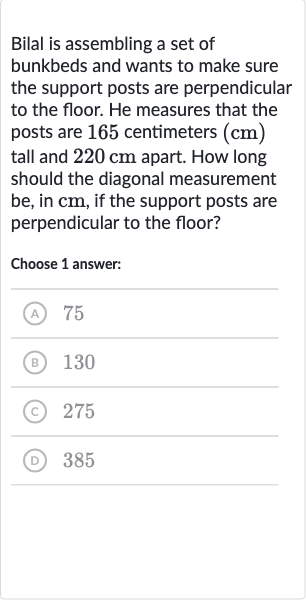AI tutor
Welcome to Bytelearn!
Let’s check out your problem:

Bilal is assembling a set of bunkbeds and wants to make sure the support posts are perpendicular to the floor. He measures that the posts are centimeters tall and apart. How long should the diagonal measurement be, in , if the support posts are perpendicular to the floor?Choose answer:(A) (B) (C) (D)
Full solution
Q. Bilal is assembling a set of bunkbeds and wants to make sure the support posts are perpendicular to the floor. He measures that the posts are centimeters tall and apart. How long should the diagonal measurement be, in , if the support posts are perpendicular to the floor?Choose answer:(A) (B) (C) (D)
- Identify Relationship and Triangle: Identify the relationship between the height of the posts, the distance apart, and the diagonal measurement.The posts and the floor form a right-angled triangle, with the posts as one side, the distance between the posts as the base, and the diagonal as the hypotenuse. We can use the Pythagorean theorem to find the length of the diagonal (hypotenuse).
- Apply Pythagorean Theorem: Apply the Pythagorean theorem.The Pythagorean theorem states that in a right-angled triangle, the square of the length of the hypotenuse () is equal to the sum of the squares of the other two sides ( and ). The formula is .
- Plug in Known Values: Plug in the known values into the Pythagorean theorem.Let's denote the height of the posts as '' ( cm), the distance apart as '' ( cm), and the diagonal as ''. So we have:
- Calculate Squares: Calculate the squares of the given numbers.
- Add Squares: Add the squares of the two sides.
- Find Square Root: Find the square root of the sum to get the length of the diagonal.
- Match with Given Options: Match the calculated diagonal length with the given options.The calculated diagonal length is , which corresponds to option (C).
More problems from Solve for a variable using properties of multiplication
QuestionGet tutor help
